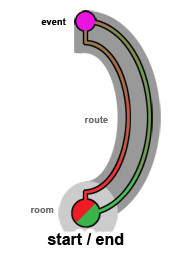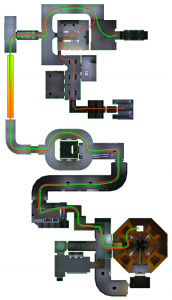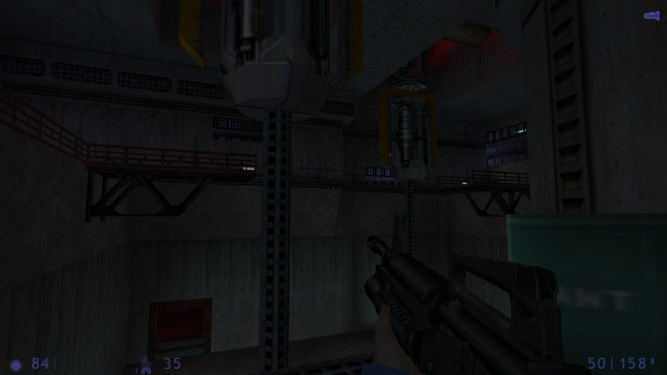Bounce (level design)
For help, see the VDC Editing Help and Wikipedia cleanup process. Also, remember to check for any notes left by the tagger at this article's talk page.
A bounce is a layout element beginning with an inaccessible area, forcing the player to sidetrack and remove an obstacle before proceeding. In some ways, it is similar to a loop. Most bounces begin in a room with an obstacle (locked door, force field, etc) and lead to an event that destroys this obstacle (disaster sequence, physics puzzle, button pushing), thus allowing the player to backtrack and proceed past the removed obstacle (unlocked door, deactivated forcefield).
Use bounces to emphasize certain plot events or gameplay elements. Always look at the "big picture" and analyze the bounce's function in context to a level's overall pacing.
Contents
Resources
In terms of resources, bounces are incredibly efficient. The same areas are being used twice. The player is literally backtracking through previous rooms, which generally translates into less work for the designer.
Guidance
Use of the same environment allows for effective guidance of the player. Since the player has already explored the area before, it is assumed that the player will partially remember the room structure and which exits. Also, it is technically impossible for the player to get lost.
Ease of Use
Bounces vary in complexity. Simple bounces involve the player fighting through rooms of monsters to activate a keypad. More intricate bounces incorporate multiple areas or objectives. Nonetheless, bounces generally require less work on the part of the designer, but more effort from the player.
Disadvantages
Unlike a loop, bounces possess no illusion of choice. The player sidetracks and returns - they are aware of their position in relation to the rest of the level. If nothing interesting happens on the return trip and it is not obvious what has happened, then, especially if it is of length, this will stick out as very badly implemented backtracking to a lot of players. To solve this problem, try making the change obvious (E.G. a video screen showing a door opening) with an immediate effect on the player (E.G. hostile soldiers attacking the player through the open door). Players don't mind backtracking when the goal seems clear or purposeful, and the trek is not overly long.
Other times, a bounce simply isn't appropriate. The player is essentially traveling in a circle and their sense of progress is diminished. During the Water Hazard and Highway 17 chapters of ![]() Half-Life 2, most bounces were either optional or short - a long extended bounce would have disrupted the focus on sheer distance and travel.
Half-Life 2, most bounces were either optional or short - a long extended bounce would have disrupted the focus on sheer distance and travel.
Implementation
In general, a bounce is much simpler to implement than a loop, but can still be effective. Here are some notable examples:
Anomalous Materials/Unforeseen Consequences ( Half-Life)
Half-Life)
This bounce is used for dramatic effect, primarily to emphasize the contrast between the pre-disaster and the post-disaster Black Mesa. When Gordon initially arrives, he is greeted by friendly NPCs and playfully chastised for being late to work again. After the resonance cascade, the player's former colleagues have mutated into zombies; dead bodies and wreckage are strewn about the level; the lighting is noticeably darker. The player comprehends the... unforeseen consequences of their actions.
From a design perspective, this bounce at the beginning of the game is very effective. Although the player is given very little direction after the resonance cascade, the player still manages to find their way through the ruined labs and up to the office complex. The player's familiarity with the labs helps the player navigate, and also serves to empower the player: they are not relying on an objective list displayed on the HUD to progress through the level, but rather relying on their own memory of the level layout as initially explored.
Power Struggle ( Half-Life: Blue Shift)
Half-Life: Blue Shift)
In this chapter, the player comes across a pool of coolant, with some barrels seen floating at the surface. The bridge above this pool has no middle part, so it is uncrossable due to the deadly coolant below. The player must drain this pool by turning a wheel, but to access it they must first use a barrel to form an electrical connection, and said barrel explodes after this. This is to suggest that barrels are useful and expendable.
After the pool is drained, the gap still cannot be crossed because the empty pool is a falling hazard, but this does allow the player to rearrange the positions of four barrels that were inside the pool. Four ceiling lights suggest to arrange the barrels in a line that could close the gap, if they had extra height. Once the player does this, they can cross the makeshift bridge safely.
Route Kanal ( Half-Life 2)
Half-Life 2)
In Route Kanal, there is a scene where the Combine cut the player's escape by closing a water lock. The player must leave the airboat, fight through a small Combine outpost, blow up a couple of flammable barrels thereby breaking open the canal doors (seen in the picture on the right), then backtrack to the airboat and proceed through.
This is the most simple type of Bounce map you can create. Its task is to hold up the player's advancement and divert them to a nearby location for them to be able to proceed further into the game.
Highway 17 ( Half-Life 2)
Half-Life 2)
In Highway 17, the famous bridge scene is a perfect example of a Bounce mission. The player must fight off a Combine drop team and a number of poison headcrab zombies, only to discover that the way onward is blocked by a force field. To disable it, the buggy must be left behind and the player has to climb their way beneath the bridge to the other side and push a button in a control room. Then, on the way back, a Combine gunship must be fought off, after which the player can proceed through the force field.
Metastasis ( MINERVA)
In this mod, the player is dropped off at an island occupied by the Combine. The player fights Combine soldiers, rollermines, and manhacks (and a few headcrabs) all the way down to the deepest reaches of the bunker under the island. At this place, a powerful amount of force wrecks the bunker, which nearly kills the player, destroys parts of the bunker, releases headcrabs, and motivates the Combine to bring reinforcements. The player then fights back up through the bunker, taking the same path mostly, but now with zombies and a destroyed environment. The player escapes the island nearly exactly where they landed on it.






